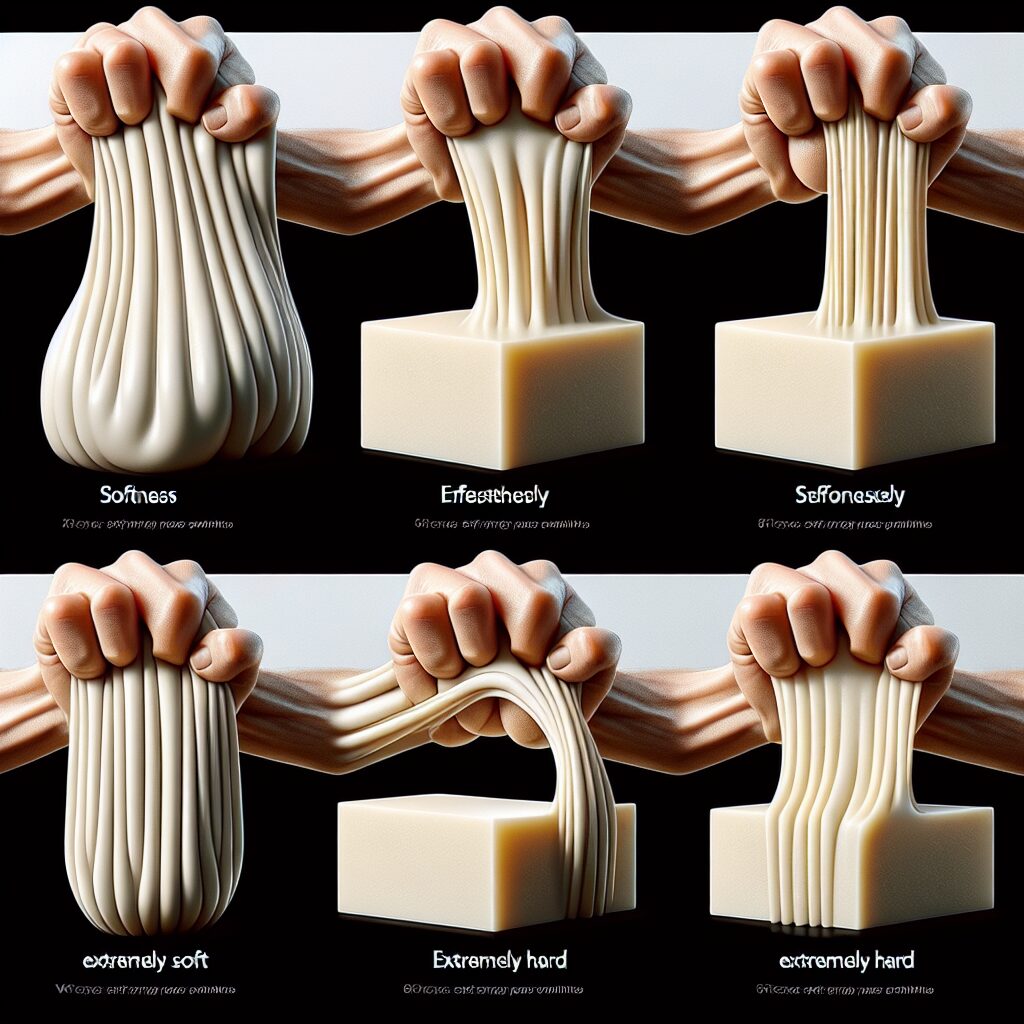Rubber hardness is a critical factor that can greatly impact the performance and quality of rubber products. It refers to the resistance of rubber to indentation or deformation when subjected to an external force. The hardness of rubber is typically measured using a durometer scale, with higher values indicating greater hardness.
Finding the ideal balance of rubber hardness is essential for achieving optimal performance in various applications. A rubber product that is too soft may lack durability and resilience, while one that is too hard may become rigid and brittle, leading to cracking or premature failure. The ideal hardness level depends on factors such as the intended use, environmental conditions, and specific requirements of the application.
In the next part of this article, we will delve into the key takeaways for finding the ideal balance of rubber hardness. We will explore the factors that influence rubber hardness, the importance of choosing the right hardness level for different applications, and the potential impacts of incorrect hardness on product performance. By understanding these key takeaways, you will be better equipped to make informed decisions when selecting rubber hardness for your specific needs. Stay tuned for valuable insights and practical tips in the upcoming sections.
Key Takeaways
1. Rubber hardness plays a crucial role in determining the performance and durability of rubber products, making it essential to find the ideal balance between flexibility and stiffness.
2. Hardness is typically measured using a durometer, with the most commonly used scale being the Shore durometer. Understanding the different durometer scales and how they apply to specific applications is essential for selecting the right rubber hardness.
3. The ideal rubber hardness varies depending on the intended application. For example, too soft rubber may lack stability and wear resistance, while extremely hard rubber can result in poor flexibility and reduced shock absorption.
4. Factors like temperature, humidity, and exposure to chemicals can influence rubber hardness. It is crucial to consider these environmental factors to ensure the long-term performance and reliability of rubber products.
5. Balancing hardness with other factors such as elasticity, tensile strength, and tear resistance is vital to achieving optimal performance and durability in rubber products. Thorough testing and evaluation are necessary to find the ideal balance for each specific application.
Rubber Hardness: How to Find the Ideal Balance for Optimal Performance?
Understanding Rubber Hardness
Rubber hardness is a crucial factor in determining the performance and functionality of rubber products across various industries. It refers to the resistance of rubber materials to indentation or deformation under applied force. The measurement of rubber hardness is typically done using a durometer, which provides a numerical value representing the material’s hardness. Different applications require different levels of hardness to ensure optimal performance.
Factors Affecting Rubber Hardness
Several factors influence the hardness of rubber:
- Type of rubber compound: Different rubber compounds have varying hardness properties. Natural rubber, synthetic rubbers, and blends all exhibit different hardness levels.
- Degree of cross-linking: The extent of cross-linking or bonding within the rubber molecules affects its hardness. Increased cross-linking usually leads to higher hardness.
- Fillers and additives: Additional materials, such as fillers and additives, can modify the hardness of rubber. For example, carbon black or silica fillers can increase hardness.
- Curing process: The curing or vulcanization process impacts the degree of hardness. Temperature, time, and pressure during curing can affect the final hardness of the rubber.
- Environmental factors: External conditions, such as temperature, humidity, and exposure to chemicals or UV radiation, can alter the hardness of rubber over time.
Importance of Finding the Ideal Balance
Optimizing rubber hardness is crucial for achieving the desired performance characteristics of the product. The right balance of hardness ensures the following:
- Proper sealing and gasketing: In applications where rubber is used for sealing purposes, the hardness must be appropriate to maintain an effective seal and prevent leakage.
- Impact resistance: In industries like automotive or construction, rubber parts with optimal hardness can withstand impacts and vibrations without deforming or losing functionality.
- Wear resistance: Harder rubber compounds offer improved resistance to wear and abrasion, making them suitable for applications requiring high durability.
- Flexibility and elasticity: Softer rubber with lower hardness allows for greater flexibility and elasticity, which is advantageous in applications that require good shock absorption or dynamic movement.
- Traction and grip: Rubber hardness influences the material’s ability to provide sufficient traction and grip. This is vital in applications like tires or footwear.
Methods for Determining Rubber Hardness
Various standardized tests and scales are used to measure rubber hardness:
- Shore durometer: The Shore A and Shore D scales are commonly employed to measure the hardness of rubber materials. A handheld durometer presses a specific indenter into the rubber surface, providing a value on the respective scale.
- IRHD (International Rubber Hardness Degrees): This method measures indentation depth using a standardized indenting foot. It provides a different hardness reference scale, which is applicable for specific rubber types.
- Other methods: There are additional specialized tests like Ball Indentation Hardness (BHI), Pusey & Jones Hardness (PJ), or International Rubber Hardness Method (IRM) that are utilized for specific applications or industries.
Balancing Hardness for Different Applications
Different applications require specific hardness levels:
- Automotive industry: Depending on the component, rubber parts may need different hardness levels. Engine mounts, for example, benefit from a harder durometer, while suspension bushings may require softer rubber.
- Industrial sealing: Gaskets and o-rings used in sealing applications need to maintain an ideal balance of hardness to ensure effective sealing and prevent leaks.
- Sports equipment: Rubber hardness is vital in sports equipment like golf balls or tennis racket grips, as it affects performance, control, and feel.
- Medical devices: Rubber used in medical devices must have an appropriate hardness to ensure comfort, flexibility, and proper functionality for patients.
Tips for Finding the Ideal Balance
- Consider the specific application requirements and the desired performance characteristics.
- Consult with rubber material experts or engineers specialized in the specific industry/application.
- Conduct thorough testing and analysis of different rubber compounds with varying hardness levels.
- Take into account the environmental factors and conditions the rubber will be exposed to during its lifecycle.
- Follow established industry standards and guidelines for hardness testing and specification.
By carefully evaluating these factors and seeking expert advice, you can find the ideal balance of rubber hardness that ensures optimal performance and longevity for your specific application.
Frequently Asked Questions
1. What is rubber hardness?
Rubber hardness refers to the measure of how resistant a rubber material is to indentation. It determines the stiffness or flexibility of the rubber.
2. Why is finding the ideal balance of rubber hardness important?
Finding the ideal balance of rubber hardness is important because it directly affects the performance and durability of rubber products. Too soft or too hard rubber can lead to problems such as poor grip, reduced flexibility, or increased vulnerability to wear and tear.
3. How is rubber hardness measured?
Rubber hardness is measured using a durometer, which is a device that applies a specific amount of force to the material and measures the depth of the indentation. The most commonly used durometer scale for rubber is the Shore A scale.
4. What factors influence the ideal rubber hardness?
The ideal rubber hardness depends on various factors, including the specific application, desired level of flexibility, anticipated load or pressure, temperature conditions, and the type of material the rubber will be in contact with.
5. What are the benefits of using softer rubber?
Softer rubber provides better grip and shock absorption, making it suitable for applications such as tires, shoe soles, or vibration isolation mounts.
6. What are the advantages of using harder rubber?
Harder rubber offers increased durability, improved resistance to compression set, and better stability under heavy loads. It is commonly used in applications such as conveyor belts, seals, or industrial components.
7. Can rubber hardness be adjusted?
Yes, rubber hardness can be adjusted by altering the mixture of raw materials, such as adding plasticizers or fillers, or by adjusting the curing process.
8. How does rubber hardness affect noise and vibration levels?
Rubber hardness plays a significant role in reducing noise and vibration levels. Softer rubber has better damping properties, effectively absorbing and minimizing vibrations and noise transmission.
9. What are the limitations of softer rubber?
Softer rubber is more prone to wear and tear, has lower tensile strength, and may not be suitable for heavy loads or high-temperature environments.
10. Can rubber hardness affect the product’s appearance?
Yes, rubber hardness can affect the product’s appearance. Softer rubber can lead to deformation or indentations, while harder rubber may appear rigid and less visually appealing.
Final Thought: Striking the Right Balance for Optimal Performance
When it comes to rubber hardness, finding the ideal balance is crucial for achieving optimal performance and longevity in various applications. Whether it’s selecting the appropriate hardness for a specific industry or adjusting the hardness for a particular product, manufacturers and engineers need to consider a multitude of factors. The right rubber hardness can enhance grip, reduce noise and vibration levels, improve durability, and withstand the demands of different environments.
Ultimately, understanding the relationship between rubber hardness and its impact on the desired properties is key. By carefully analyzing the application requirements and considering factors such as load, temperature, material compatibility, and performance expectations, professionals can make informed decisions to strike the perfect balance and unlock the full potential of rubber products.




